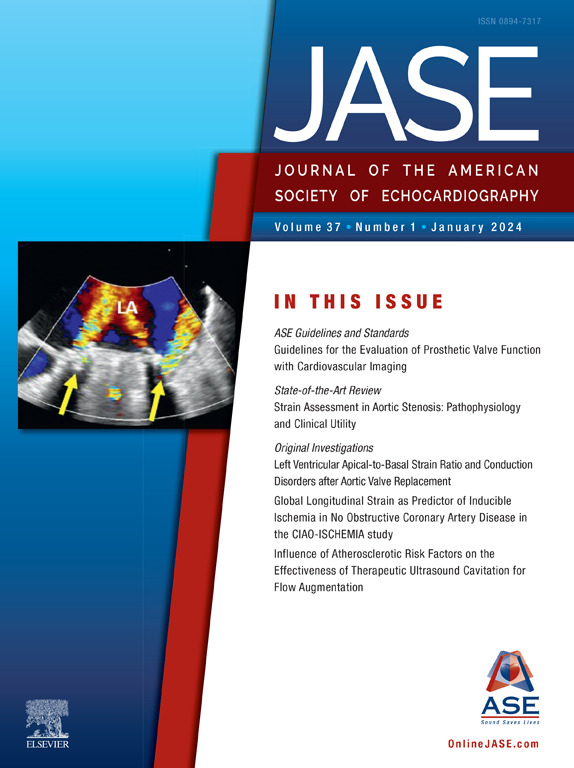无创三维超声心动图压力-容积分析:一种评估左心室功能的新有效方法。
IF 6
2区 医学
Q1 CARDIAC & CARDIOVASCULAR SYSTEMS
Journal of the American Society of Echocardiography
Pub Date : 2025-10-01
DOI:10.1016/j.echo.2025.05.008
引用次数: 0
摘要
背景:压力-容积(PV)分析是评价左心室(LV)功能的金标准,但由于其侵入性,临床上很少使用。我们验证了一种无创的三维超声心动图PV分析方法与有创参考测量方法的对比,以及一种新的左室效率指标与由正电子发射断层扫描-计算机断层扫描(PET/CT)代谢得出的左室效率的对比。方法:采用压电晶体有创测量22只犬的左室体积,微压计测量左室压力。超声心动图和峰值压力得到三维左室容积迹线和左室压力迹线估计。通过超声心动图获得脑卒中功、单次搏动收缩指数、动脉弹性和左室效率指数,并与基线和不同干预措施下的有创测量结果进行比较。在12只羊中,将左室效率指数与以卒中功除以PET/CT总左室糖代谢计算的效率进行比较。绵羊进行了8周的快速非同步起搏以诱发心力衰竭(HF)。在同步和非同步电激活、基线和8周起搏诱发HF后进行记录。结果:在犬中,无创和有创左室卒中功测量具有很好的相关性和一致性(r=0.98, p)。结论:三维超声心动图无创PV分析是可行和准确的,使评价左室功能的PV环路参数可用于临床。进一步的研究应探讨该方法的临床应用。本文章由计算机程序翻译,如有差异,请以英文原文为准。
Noninvasive Pressure-Volume Analysis by Three-Dimensional Echocardiography: A Novel Powerful Method for Evaluating Left Ventricular Function
Background
Pressure-volume (PV) analysis is the gold standard for evaluating left ventricular (LV) function but is rarely used clinically due to its invasiveness. We validated a noninvasive method for PV analysis by three-dimensional (3D) echocardiography against invasive reference measurements and a novel index of LV efficiency against LV efficiency derived from metabolism by positron emission tomography-computed tomography (PET-CT).
Methods
In 22 canines, LV volume was measured invasively using piezoelectric crystals and LV pressure by micromanometer. Echocardiography and peak pressure were used to obtain 3D LV volume traces and LV pressure trace estimates. Stroke work, single-beat contractility indices, arterial elastance, and an index of LV efficiency were derived from echocardiography and compared with their invasively measured counterparts at baseline and different interventions. In 12 sheep, the LV efficiency index was compared with efficiency calculated as stroke work divided by total LV glucose metabolism from PET-CT. The sheep underwent 8 weeks of rapid dyssynchronous pacing to induce heart failure (HF). Recordings were performed during synchronous and dyssynchronous electrical activation, at baseline, and after 8 weeks of pacing-induced HF.
Results
In canines, there was a very good correlation and agreement between noninvasive and invasive measurements of LV stroke work (r = 0.98, P < .0001; difference 237 ± 212 mm Hg × mL, mean ± SD). The noninvasive and invasive efficiency indices also showed very good agreement (r = 0.95, P < .0001; difference 0.4% ± 3.4%). The changes in LV function by the different interventions resulted in similar changes in the noninvasive and invasive PV indices (all P < .001). In sheep, the efficiency index showed similar decline compared to efficiency by PET-CT after induction of HF and after switching from synchronous to dyssynchronous electrical activation (r = 0.67, P < .001 for all interventions).
Conclusions
Noninvasive PV analysis by three-dimensional echocardiography is feasible and accurate, making PV loop parameters for evaluating LV function accessible for clinical use. Further studies should explore the clinical utility of this method.
求助全文
通过发布文献求助,成功后即可免费获取论文全文。
去求助
来源期刊
CiteScore
9.50
自引率
12.30%
发文量
257
审稿时长
66 days
期刊介绍:
The Journal of the American Society of Echocardiography(JASE) brings physicians and sonographers peer-reviewed original investigations and state-of-the-art review articles that cover conventional clinical applications of cardiovascular ultrasound, as well as newer techniques with emerging clinical applications. These include three-dimensional echocardiography, strain and strain rate methods for evaluating cardiac mechanics and interventional applications.

 求助内容:
求助内容: 应助结果提醒方式:
应助结果提醒方式:


